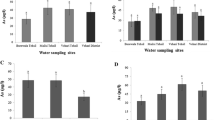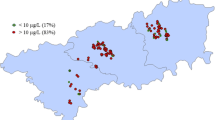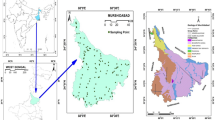Abstract
Groundwater is the most valuable natural source in our earth’s planet, being contaminated in various regions worldwide. Despite considerable research, there are scarce data regarding arsenic (As) levels in groundwater and its build-up in biological samples in Pakistan. The current investigation analyzed As contamination in four tehsils of District Khanewal (Kabirwala tehsil, Jahaniyan tehsil, Mian Channu tehsil, and Khanewal tehsil). For that, 123 groundwater samples, 19 animal milk samples, 20 human nails, and 20 human hair samples were collected from the study area. Arsenic concentration in groundwater was up to 51.8 µg/L with an average value of 7.2 µg/L. About 28 water samples (23%) had As contents > WHO limit and 38 samples (31%) > DEP-NJ limit. Low levels of As were detected in biological samples. Average As levels were 23 µg/L in the milk samples and 298 µg/kg in human hair. Arsenic contents were not detected in nail samples, except in one sample from Kabirwala tehsil. The maximum values of hazard quotient and cancer risk in District Khanewal were 4.9 and 0.0022, respectively. It is anticipated that long-term use of As-containing water may led to poisoning of humans in the study area, especially in Kabirwala. Therefore, it is necessary to monitor As contamination in the groundwater of Kabirwala tehsil to reduce the potential health hazards.


Similar content being viewed by others
Data availability
All data and materials as well as software application support their published claims and comply with field standards.
References
Akhter, G., & Hasan, M. (2016). Determination of aquifer parameters using geoelectrical sounding and pumping test data in Khanewal District, Pakistan. Open Geosciences, 8, 630–638.
Alothman, Z. A., & Shahid, M. (2022). Recent advances in removal of toxic elements from water using MOFs: A critical review. Arabian Journal of Chemistry, 15, 104319.
Amir, M., Asghar, S., Ahsin, M., Hussain, S., Ismail, A., Riaz, M., & Naz, S. (2021). Arsenic exposure through drinking groundwater and consuming wastewater-irrigated vegetables in Multan, Pakistan. Environmental Geochemistry and Health, 43, 5025–5035.
Chakraborti, D., Rahman, M. M., Ahamed, S., Dutta, R. N., Pati, S., & Mukherjee, S. C. (2016). Arsenic groundwater contamination and its health effects in Patna district (capital of Bihar) in the middle Ganga plain, India. Chemosphere, 152, 520–529.
Din, I. U., Muhammad, S., & Rehman, Iu. (2023). Heavy metal(loid)s contaminations in soils of Pakistan: A review for the evaluation of human and ecological risks assessment and spatial distribution. Environmental Geochemistry and Health, 45, 1991–2012.
Estefan, G. (2013). Methods of soil, plant, and water analysis: a manual for the West Asia and North Africa region. International Center for Agricultural Research in the Dry Areas (ICARDA).
Feldmann, J., John, K., & Pengprecha, P. (2000). Arsenic metabolism in seaweed-eating sheep from Northern Scotland. Fresenius’ Journal of Analytical Chemistry, 368, 116–121.
Kazi, T. G., Arain, M. B., Baig, J. A., Jamali, M. K., Afridi, H. I., Jalbani, N., Sarfraz, R. A., Shah, A. Q., & Niaz, A. (2009). The correlation of arsenic levels in drinking water with the biological samples of skin disorders. Science of the Total Environment, 407, 1019–1026.
Kumar, L., Deitch, M. J., Tunio, I. A., Kumar, A., Memon, S. A., Williams, L., Tagar, U., Kumari, R., & Basheer, S. (2022). Assessment of physicochemical parameters in groundwater quality of desert area (Tharparkar) of Pakistan. Case Studies in Chemical and Environmental Engineering, 6, 100232.
Lone, S. A., Jeelani, G., Mukherjee, A., & Coomar, P. (2021). Arsenic fate in upper Indus river basin (UIRB) aquifers: Controls of hydrochemical processes, provenances and water-aquifer matrix interaction. Science of the Total Environment, 795, 148734.
Merola, R. B., Hien, T. T., Quyen, D. T. T., & Vengosh, A. (2015). Arsenic exposure to drinking water in the Mekong Delta. Science of the Total Environment, 511, 544–552.
Nagra, M. A., Natasha, N., Bibi, I., Tariq, T. Z., Naz, R., Ansar. S., Shahid, M., Murtaza, B., Imran, M., Khalid, M. S., Masood, N., Shah, G. M., Niazi, N. K., Dumat, C. (2022) Biowaste-based sorbents for arsenic removal from aqueous medium and risk assessment. Environmental Geochemistry and Health
Nandi, D., Patra, R., & Swarup, D. (2005). Effect of cysteine, methionine, ascorbic acid and thiamine on arsenic-induced oxidative stress and biochemical alterations in rats. Toxicology, 211, 26–35.
Natasha, N., Shahid, M., Khalid, S., Niazi, N. K., Murtaza, B., Ahmad, N., Farooq, A., Zakir, A., Imran, M., & Abbas, G. (2021). Health risks of arsenic buildup in soil and food crops after wastewater irrigation. Science of the Total Environment, 772, 145266.
Natasha, N., Shahid, M., Murtaza, B., Bibi, I., Khalid, S., Al-Kahtani, A. A., Naz, R., Ali, E. F., Niazi, N. K., Rinklebe, J., & Shaheen, S. M. (2022c). Accumulation pattern and risk assessment of potentially toxic elements in selected wastewater-irrigated soils and plants in Vehari, Pakistan. Environmental Research, 214, 114033.
Natasha, S. M., Khalid, S., Bibi, I., Khalid, S., Masood, N., Qaisrani, S. A., Niazi, N. K., & Dumat, C. (2022a). Arsenic-induced oxidative stress in Brassica oleracea: Multivariate and literature data analyses of physiological parameters, applied levels and plant organ type. Environmental Geochemistry and Health, 44, 1827–1839.
Natasha, S. M., Khalid, S., & Saleem, M. (2022b). Unrevealing arsenic and lead toxicity and antioxidant response in spinach: A human health perspective. Environmental Geochemistry and Health, 44, 487–496.
Rabbani, U., Mahar, G., Siddique, A., & Fatmi, Z. (2017). Risk assessment for arsenic-contaminated groundwater along River Indus in Pakistan. Environmental Geochemistry and Health, 39, 179–190.
Rahaman, M. S., Mise, N., & Ichihara, S. (2022). Arsenic contamination in food chain in Bangladesh: A review on health hazards, socioeconomic impacts and implications. Hygiene and Environmental Health Advances, 2, 100004.
Rasheed, H., Iqbal, N., Ashraf, M., & ul Hasan, F. (2022). Groundwater quality and availability assessment: A case study of District Jhelum in the Upper Indus, Pakistan. Environmental Advances, 7, 100148.
Rasool, A., Xiao, T., Farooqi, A., Shafeeque, M., Liu, Y., Kamran, M. A., Katsoyiannis, I. A., & Eqani, S. A. M. A. S. (2017). Quality of tube well water intended for irrigation and human consumption with special emphasis on arsenic contamination at the area of Punjab, Pakistan. Environmental Geochemistry and Health, 39, 847–863.
Rokonuzzaman, M. D., Li, W. C., Wu, C., & Ye, Z. H. (2022). Human health impact due to arsenic contaminated rice and vegetables consumption in naturally arsenic endemic regions. Environmental Pollution, 308, 119712.
Rosas, I., Belmont, R., Armienta, A., & Baez, A. (1999). Arsenic concentrations in water, soil, milk and forage in Comarca Lagunera, Mexico. Water, Air, and Soil Pollution, 112, 133–149.
Samiee, F., Leili, M., Faradmal, J., Torkshavand, Z., & Asadi, G. (2019). Exposure to arsenic through breast milk from mothers exposed to high levels of arsenic in drinking water: Infant risk assessment. Food Control, 106, 106669.
Sanz, E., Muñoz-Olivas, R., Cámara, C., Sengupta, M. K., & Ahamed, S. (2007). Arsenic speciation in rice, straw, soil, hair and nails samples from the arsenic-affected areas of Middle and Lower Ganga plain. Journal of Environmental Science and Health, Part A, 42, 1695–1705.
Shah, A. H., Shahid, M., Khalid, S., Shabbir, Z., Bakhat, H. F., Murtaza, B., Farooq, A., Akram, M., Shah, G. M., & Nasim, W. (2020). Assessment of arsenic exposure by drinking well water and associated carcinogenic risk in Peri-Urban areas of Vehari, Pakistan. Environmental Geochemistry and Health, 42, 121–133.
Shah, A. H., Shahid, M., Tahir, M., Natasha, B. I., Tariq, T. Z., Khalid, S., Nadeem, M., Abbas, G., Saeed, M. F., Ansar, S., & Dumat, C. (2022). Risk assessment of trace element accumulation in soil and Brassica oleracea after wastewater irrigation. Environmental Geochemistry and Health. https://doi.org/10.1007/s10653-022-01351-4
Shahid, M. (2021). Effect of soil amendments on trace element-mediated oxidative stress in plants: Meta-analysis and mechanistic interpretations. Journal of Hazardous Materials, 407, 124881.
Shahid, M., Al-Kahtani, A. A., Alothman, Z. A., Bibi, I., Tariq, T. Z., Natasha, N., Khalid, S., Niazi, N. K., & Murtaza, B. (2023a). Effect of freshwater and wastewater irrigation on buildup of toxic elements in soil and maize crop. Environmental Monitoring and Assessment, 195, 438.
Shahid, M., Khalid, M., Dumat, C., Khalid, S., Niazi, N. K., Imran, M., Bibi, I., Ahmad, I., Hammad, H. M., & Tabassum, R. A. (2018a). Arsenic level and risk assessment of groundwater in Vehari, Punjab Province, Pakistan. Exposure and Health, 10, 229–239.
Shahid, M., Khalid, S., Natasha, N., Tariq, T. Z., Alothman, Z. A., Al-Kahtani, A. A., Imran, M., & Murtaza, B. (2023b). Spatial distribution and accumulation of arsenic in biological samples and associated health risks by drinking groundwater in Bahawalnagar, Pakistan. Physics and Chemistry of the Earth, Parts a/b/c, 130, 103397.
Shahid, M., Niazi, N. K., Dumat, C., Naidu, R., Khalid, S., Rahman, M. M., & Bibi, I. (2018b). A meta-analysis of the distribution, sources and health risks of arsenic-contaminated groundwater in Pakistan. Environmental Pollution, 242, 307–319.
Shaji, E., Santosh, M., Sarath, K. V., Prakash, P., Deepchand, V., & Divya, B. V. (2021). Arsenic contamination of groundwater: A global synopsis with focus on the Indian Peninsula. Geoscience Frontiers, 12, 101079.
Shakoor, M. B., Bibi, I., Niazi, N. K., Shahid, M., Nawaz, M. F., Farooqi, A., Naidu, R., Rahman, M. M., Murtaza, G., & Lüttge, A. (2018). The evaluation of arsenic contamination potential, speciation and hydrogeochemical behaviour in aquifers of Punjab, Pakistan. Chemosphere, 199, 737–746.
Singh, N., Kumar, D., & Sahu, A. P. (2007). Arsenic in the environment: effects on human health and possible prevention. Journal of Environmental Biology, 28, 359–365.
US-EPA. (2005). Guidelines for Carcinogen Risk Assessment; EPA/630/P-03/001F; Risk Assessment Forum: Washington, DC, USA. Accessed, December, 14, 2022
Acknowledgements
Dr Shahid thanks HEC-Pakistan for NRPU#7770 project. A. A. Al-Kahtani thanks the researchers supporting project number (RSP2023R266), King Saud University, Riyadh, Saudi Arabia, for their financial support.
Author information
Authors and Affiliations
Contributions
NUK involved in research work, sampling, and initial draft. MS supervised the research work, scientific perception, organization, experimental supervision, sample collection, data analysis, write-up, and correspondence. SK involved in research work, analysis, literature data analysis, writing the initial draft. NN took part in research work, collection and analysis of water samples, literature review, writing, preparing tables and figures, PCA. ZAA involved in project collaborator, visualization, review, editing and improving the entire article. AAA-K is a project partner, took part in conceptualization of research work, reviewed and improved article. MI involved in conceptualization of research, IDW of data, reviewed article. BM took part in conceptualization of research work, PCA, reviewed and edited article.
Corresponding author
Ethics declarations
Conflict of interest
All authors declare no conflict of interest.
Animal research
Not applicable.
Consent to participate
Not applicable.
Consent to publish
Not applicable.
Additional information
Publisher's Note
Springer Nature remains neutral with regard to jurisdictional claims in published maps and institutional affiliations.
Supplementary Information
Below is the link to the electronic supplementary material.
Rights and permissions
Springer Nature or its licensor (e.g. a society or other partner) holds exclusive rights to this article under a publishing agreement with the author(s) or other rightsholder(s); author self-archiving of the accepted manuscript version of this article is solely governed by the terms of such publishing agreement and applicable law.
About this article
Cite this article
Khan, N.U., Shahid, M., Khalid, S. et al. Arsenic level in groundwater and biological samples in Khanewal, Pakistan. Environ Geochem Health 45, 8943–8952 (2023). https://doi.org/10.1007/s10653-023-01682-w
Received:
Accepted:
Published:
Issue Date:
DOI: https://doi.org/10.1007/s10653-023-01682-w




